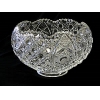 Crystal is the
decorative glass that is different from the other glass with the high concentration
of lead oxide giving that famous brilliant shine. It increases the refractive index
and color dispersion to the diamond purity, thus allowing breaking up into the
rainbow colors as well as the diamond does. Baryta is sometimes added to give
the increased index of retraction. Crystal is the
decorative glass that is different from the other glass with the high concentration
of lead oxide giving that famous brilliant shine. It increases the refractive index
and color dispersion to the diamond purity, thus allowing breaking up into the
rainbow colors as well as the diamond does. Baryta is sometimes added to give
the increased index of retraction.
It is
curious but such a fragile mineral originated as a result of wars. The military
actions in Great Britain caused James I, the King, to forbid using wood in
production, apart from shipbuilding purposes.
Glass production
required high temperature and they set using coal for furnaces at glasshouses
that would use wood previously as their main fuel material. And at that exact time,
the unique effect of glass decolorizing was accidentally revealed, which assumed
the higher index of refraction.
Plenty of
experiments using various chemical additives resulted in 1676 George
Ravenscroft, the glassmaker, developed the technology of the heavy and durable
glass characterized by its brilliance, clarity and highly refractive quality with
some lead oxide concentration. It ushered a new style in glassmaking and
eventually made England the leading glass producer of the world. Lead oxide additives
facilitated increase in index of refraction to the highest extent possible for
that time. Besides, the lead crystal glass was resistant to acids and alkaline.
Currently the world standard of the lead oxide concentration in crystal makes
24%, yet the technology invented by George Ravenscroft for the lead crystal has
not undergone sea changes. Only the equipment has been sophisticated.
Later on, other
additives were also discovered that furthered to modify the features of the
plain glass and make it into the crystal, but with some different refraction
and dispersion. Thus, apart from the lead crystal, there is baric crystal, and
barium oxide is used to produce such crystal instead of lead oxide. Yet, definitely,
the famous Bohemian crystal known as the best crystal in the world, is produced
by adding potash calcium glass added to the glass mass to replace lead oxide or
barium oxide.
Stained
crystal then came out that is still popular in public. Crystal may change its
color with various additive agents added to it. So, cadmium or gold compounds
bring the red tint, while the silicon adds a pink color to crystal; cobalt
gives luxury blue color, and copper-oxide provides the green of grass, while
the manganese oxides bring the violet depth of the night sky. Among the colored
crystal the pearl grey, amethyst and azure crystal made by the royal shops in Sevres,
France.
There is
another ever popular kind of crystal, so called frosty crystal. To gain the effect
of frosty surface, the crystal item is treated by the hydrofluoric acid and as
the result, the surface that previously not coated with the special acid-proof
tar, becomes matte. The frosty crystal things appear stylish and superior, and
they truly impress.
The
technique of crystal treatment is the diamond cutting accepted from the ancient
times. Using this technology, the items are treated with the rotating circles
of the artificial diamond with the subsequent polishing by acids. As a result,
we enjoy the trendiest option of the crystal that is opalescent like a diamond
with all colors of the rainbow.
The crystal
became popular in other countries in the end of XVIII, almost a century after
George Ravenscroft developed his unique technology. The crystal dishware
manufactured in old times in Russia for instance, are traced and chased by
collectors, since it is of historical and artistic value as well.
In 1892
Daniel Swarovski invented a crystal cutting machine which was faster and more
precise than hand cutting. And it was Swarovski's technology that has been used
all wide and helps to draw vivid attention to crystal as both to the material
to manufacture dishware from and to the jewelry. Swarovski Company now manufactures
approximately 80% of all the glass gems for bijouterie, apart from the various
eye-catching dishwares, bras and other items. Daniel Swarovski found crystal as
one of the unusual and wonderful material and never intended to hide it for
something else. His technology in fact is the promotion of crystal as the
wonderful mineral as such but absolutely not because crystal resembles diamond.
Yet, Swarovski's works made the crystal trendy, from jewelry to interior
decoration items. Thanks to Daniel Swarovski, the use of crystal is widely
practiced in all the spheres. It is used in paintings, household appliances and
lightings, interior decoration and furniture. Crystal is also used in manufacture
of bathroom equipment.
Currently
various materials are marketed which are far less expensive than crystal.
Nevertheless, the brilliance of the crystal is always in. Chic and decency of
crystal pieces, their natural transparence is not feasible to replicate, thus
crystal stays the mineral of all ages.
|